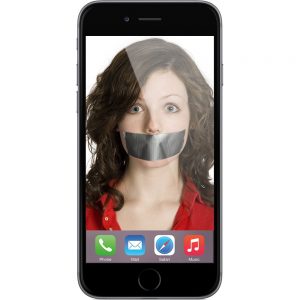In a development that could have wide ramifications for free speech, Apple was granted a patent at the end of last month for a system that enables blocking of both still and video recording. According to the details given on the USPTO website, the patent is titled as “systems and methods for receiving infrared data with a camera designed to detect images based on visible light”. The system is described as relating to infrared data transmission and is envisaged to have a camera designed to detect images based on visible light and an image processing circuitry electrically coupled to the camera. This circuitry can determine whether the image captured by the camera has any infrared signal coded with data and if so, decode it. Thus, it is claimed to have additional functionalities that a normal camera attached to electronic devices does not have.
The pros and cons
The patent application itself describes two situations in which the system can be put to use. One is in a setting like museum, wherein an infrared emitter may be kept near an artefact and it can emit infrared signals with data that contains information about the particular object, which can then be decoded using the system proposed by Apple. Another scenario is when an infrared emitter can send out signals containing commands to disable recording devices. This is useful in situations where recording is prohibited- say a cinema hall or a concert. Thus, spectators recording and illegally uploading the recordings on video sharing websites without permission can be stopped using this technology. Similarly, the disturbance caused to both the performer and other viewers due to distracting flashlights emitted during recording can also be curbed. Notably, many artists (see here and here) have expressed their displeasure at people recording their performances. In fact, American singer Alicia Keys, recently asked her viewers to put away their phones in a lockable pouch to avoid disturbances during the performance.
The system, thus one can say, acts as a sort of a technological protection measure (TPM) which is a common form of Digital Rights Management (“DRM”). As TPMs allow the copyright owner to place restrictions on the use of a file, this system, if implemented, would allow the performers and copyright holders to prevent the recording of their performances and works and thereby obviating the chances of infringement of their rights by illegal sharing of these recordings. Also, similar to TPMs, this system, though may prove useful to performers and copyright owners, runs the risk of overstepping the rights granted by copyright law by imposing unnecessary restrictions. Disabling of recording would prevent the audience from making recordings for even those purposes that do not amount to infringement. For instance, under section 38 of the Indian Copyright Act, 1957, the performers have the right to prevent recording of their performances without their consent. However, as per section 39(a), they cannot prevent so if made for private use or for bona fide teaching or research purposes.
Further, though both the examples cited in the application paint the system in a positive light, people are sceptical whether the same system could be used to muffle freedom of speech. It could be potentially used by governments to prevent protesters from recording visuals of police brutality or an illegal crackdown. It may be remembered that a mass movement like ‘Arab Spring’ was in large measure made possible by people recording videos and live streaming them to gather more support. Recently, Democrats in the US used the tool ‘Periscope’ to put on air live their protests against the gun control legislation, despite the Republicans cutting off the video feed used by the cable television network.
Thus, despite the minor annoyances that recordings may cause, the immense impact it has had on enabling a more open and democratic society cannot be overlooked. A system like the one in question opens up the possibility of both individuals and governments using it to silence the voice of dissenters.
Summing Up
Though the patent raises credible doubts over its potential misuse, many point to the track record of Apple, which has in the past, blocked the efforts by the government to infringe on civil liberties. Thus, it is felt by some that it is in fact a blessing in disguise that it is Apple, which has patented the system. This would mean that the system may never be converted to a viable product and introduced in the market, thereby avoiding the possibility of such a technology being ever misused. Furthermore, the system can only be used to disable phones that can detect infrared signals. Thus, unless all the manufacturers join the bandwagon, it is not going to be possible to disable all the devices out there.
Nevertheless, considering that the most fundamental of civil liberties is at stake, we would do well to raise our guards. Given how technology has already started impeding our basic freedoms, we cannot afford to yield more ground.
(Image taken from here).
